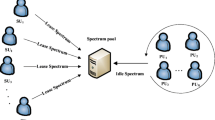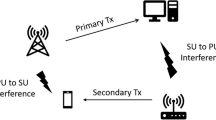Abstract
With the development of cognitive radio technologies, dynamic spectrum access (DSA) techniques are being regarded as a promising approach to increase the efficiency of spectrum utilization and to solve spectrum scarcity problem. This comes as a greater challenge in a cellular network where there are multiple primary users (PUs) who communicate with their access point while the other secondary users (SUs) want to use PU’s spectrum. On the other hand, heterogeneity in terms of space and frequency can affect the primary users’ decision to release their spectrum to the SUs. In this respect, the present paper is intended to address this issue and thus propose a solution with regard to the reward and punishment policy and equivalent revenue per unit transmission parameter. It has to be noted that both PUs and SUs aim to maximize their utilities in terms of their transmission rate and revenue/payment. Therefore, the proposed model is formulated as a Stackelberg Game, and a unique Nash Equilibrium Point is achieved by analytical procedure. Based on the analyses, the paper presents the conditions under which cooperation will enhance the performance of the whole system. Both analytical and numerical results reveal that the cooperative cognitive radio framework is a promising framework under which the utility of both the primary and secondary systems is maximized.















Similar content being viewed by others
References
Hossain, E., Niyato, D., & Han, Z. (2009). Dynamic spectrum access and management in cognitive radio networks. Cambridge: Cambridge University Press.
Wang, B., & Liu, K. R. (2011). Advances in cognitive radio networks: A survey. Selected Topics in Signal Processing, IEEE Journal of, 5(1), 5–23.
Moradkhani, M., Azmi, P., & Pourmina, M. A. (2014). Optimized reliable data combining cooperative spectrum sensing method in cognitive radio networks. Wireless Personal Communications, 74(2), 569–583.
Haqiqatnejad, A. R., Shahtalebi, K., & Forouzan, A. R. (2014). Spectrum leasing with disjoint secondary user selection in cognitive radio networks. In Communication and Information Theory (IWCIT), 2014 Iran Workshop on (pp. 1–6), IEEE.
Zhu, K., Niyato, D., Wang, P., & Han, Z. (2012). Dynamic spectrum leasing and service selection in spectrum secondary market of cognitive radio networks. Wireless Communications, IEEE Transactions on, 11(3), 1136–1145.
Zhang, J., & Zhang, Q. (2009). Stackelberg game for utility-based cooperative cognitive radio networks. In Proceedings of the Tenth ACM International Symposium on Mobile Adhoc Networking and Computing (pp. 23–32).
Yi, Y., Zhang, J., Zhang, Q., & Jiang, T. (2011). Spectrum leasing to multiple cooperating secondary cellular networks. In Communications (ICC), 2011 IEEE International Conference on (pp. 1–5), IEEE.
Simeone, O., Stanojev, I., Savazzi, S., Bar-Ness, Y., Spagnolini, U., & Pickholtz, R. (2008). Spectrum leasing to cooperating secondary ad hoc networks. Selected Areas in Communications, IEEE Journal on, 26(1), 203–213.
Wang, H., Gao, L., Gan, X., Wang, X., & Hossain, E. (2010). Cooperative spectrum sharing in cognitive radio networks: A game-theoretic approach. In Communications (ICC), 2010 IEEE International Conference on (pp. 1–5), IEEE.
Toroujeni, S. M. M., Sadough, S. S., & Ghorashi, S. A. (2010). Time-frequency spectrum leasing for OFDM-based dynamic spectrum sharing systems. In Wireless Advanced (WiAD), 2010 6th Conference on (pp. 1–5), IEEE.
Toroujeni, S. M. M., Sadough, S. M. S., & Ghorashi, S. A. G. (2013). Spectrum leasing for OFDM-based cognitive radio networks. Vehicular Technology, IEEE Transactions on, 62(5), 2131–2139.
Elkourdi, T., & Simeone, O. (2012). Spectrum leasing via cooperation with multiple primary users. Vehicular Technology, IEEE Transactions on, 61(2), 820–825.
Zhang, Y., Leng, S., & Zeng, M. (2012). An auction-theoretic spectrum leasing scheme for cognitive radio networks. In Computational Problem-Solving (ICCP), 2012 International Conference on (pp. 29–34), IEEE.
Pourmina, M. A., & MirMotahhary, N. (2012). Load balancing algorithm by vertical handover for integrated heterogeneous wireless networks. EURASIP Journal on Wireless Communications and Networking, 2012(1), 1–17.
Feng, X., Chen, Y., Zhang, J., Zhang, Q., & Li, B. (2012). TAHES: Truthful double auction for heterogeneous spectrums. In INFOCOM, 2012 Proceedings IEEE (pp. 3076–3080), IEEE.
Bahadori-Jahromi, F., Pourmina, M. A., & Masnadi-Shirazi, M. A. (2014). Performance of cooperative spatial multiplexing SISO/MIMO communication systems with constellation rearrangement technique. Arabian Journal for Science and Engineering, 39(2), 1067–1078.
Propagation data and prediction methods for the planning of indoor radiocommunication systems and radio local area networks in the frequency range 900 MHz to 100 GHz. Recommendation ITU-R P.1238-1, 1999.
Author information
Authors and Affiliations
Corresponding author
Appendix
Appendix
Proof for (14).
Rights and permissions
About this article
Cite this article
Pourmina, M.A., Moradikia, M. Stackelberg Game on Space and Frequency Heterogeneity Analysis in an OFDMA-Based Cognitive Spectrum Leasing. Wireless Pers Commun 84, 341–359 (2015). https://doi.org/10.1007/s11277-015-2611-z
Published:
Issue Date:
DOI: https://doi.org/10.1007/s11277-015-2611-z




